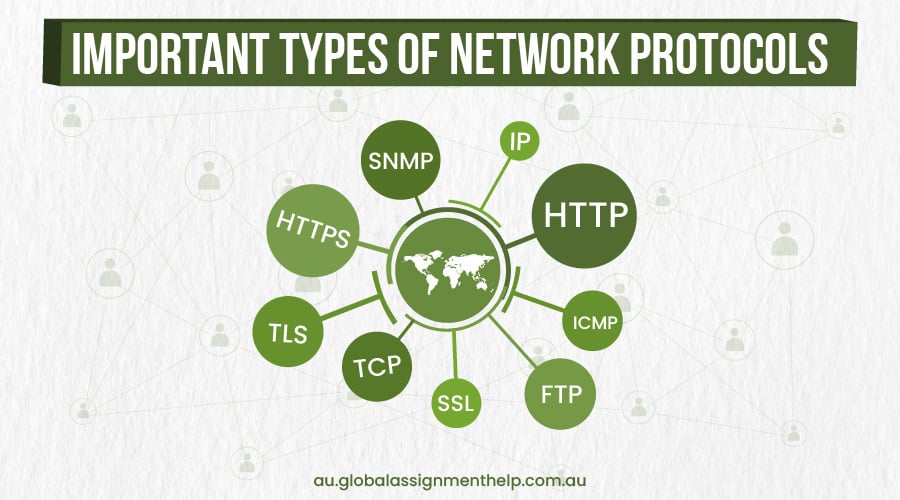 Offers
New
Order Now
Offers
New
Order Now
Communication is chief in transmitting any kind of information. You talk to a person and convey a detail through words. Similarly, devices also communicate with each other. Just like your language has a name which is English, even they have one too. That is the network protocols that allow two connected systems to transfer a piece of information with each other safely. It is a general idea to build an understanding of the topic, but you need more data to have strong conceptual knowledge. Most of you avoid going on this path as the details become complex. Hence, this article discloses answers to What is a network protocol by explaining its vital aspects.
So, let us discuss the meaning and how it works first to complete the initial stage of learning. Now, you must pay focus on this moment.
Before handling and processing the complex details, you must point to a simple task. Here, it is to learn What is a network protocol and how it works to help two devices communicate.
You follow some rules while talking to another person for better understanding. Similarly, two electronic devices also use some norms to transfer data. So, by this term, you can understand that it is a set of principles that determine a smooth connection between two or more systems to support crack-free transportation of details. Network protocols are the base language to facilitate the smooth process even when there are differences in the machines, operating systems or internal procedures.
Protocols are essential in determining the best way to communicate by giving in-depth details on the processes that support the function of data transmission. They are-
When two or more protocols join forces to support one of these processes, it is termed a protocol family. Let’s understand this through an example, as they help in simplifying a situation or case.
This is a general introduction to what processes are usually involved and how handling them forms a group of internet protocols (IP). This heading includes all the generally used protocols by the public that allow home network operators and other local area systems to spread data with each other.
IP is safe and works smoothly when the information is sent from one device to another as a one-way communication. This protocol has no space for conversion, where information can transmit from both ways. That is when you require another protocol to increase the level of internet protocols, so TCP comes to the rescue. It stands for Transmission Control Protocol which combines with IP to transmit the data banks successfully by dispatching packets.
So, TCP join hands with IP to extend its layer capacity to a level higher than the current. It helps to enable the condition of point-to-point connections that are vital for transmitting information. Every protocol type has a specific area where they operate. When they combine, like TCP/IP, the specified area in the stack of network protocols is in the middle layers. Some famous applications prefer this combination, yet most servers and browsers prefer applying HTTP. Thus, this group ranks at the top of lower-level operators like Ethernet, ARP, ICMP and FTP.
After reading both sections, you can understand the complete meaning of computer network protocols and how it works. Even though it is no rocket science doubts do come to your mind due to its complex process. Our experts say that questions only come when you have not learned about a subject completely. Once you do that, that query gets erased. So, by keeping this in mind let us study further about the vital uses of network protocols.
The internal process of sharing and accessing the data on the web depends on this element. The purpose for which it is used is broadly divided into three sub-categories:
These above-mentioned divisions have individual responsibilities that make them useful in the fluid and unbreakable process of a network protocol. Our experts have a say that once you grasp the correct understanding of these segments, you can answer the two questions, ”What is a network protocol? and its use. So, let us give them a thorough reading:
If you observe the entire process, communication protocols stand at the top of the ranks. Without them, you cannot possibly think of transmitting information between two devices. They frame the necessary rules to set up the communication process to send the data. The syntax, detecting errors, authentication, etc., are a few processes handled by these network protocols.
As a programmer, you get a task to develop such protocols that can form an undisturbed link between the two devices. Since you are learning, you should know about them, so here is for your idea:
The work of management does not change even if you change the profession or field. It simply means to analyse, maintain, and monitor the work at hand. In network protocols, there are some who do the job of transmitting the information, whereas a handful look out over the process and manage stable communication.
Let’s see the sub-divisions of this category and understand protocols that handle the smooth flow of the process:
The network protocols designed under this division are solely responsible for securing the data over a network. Moreover, they determine the procedure to save the data from unauthentic tries to steal or view the information. It is their duty to ensure that none of these devices or users can access the details through their system.
Now that the concept is clear, it is time to take a programming assignment help to observe the division under this category:
What if either of these does not exist? Can you go through the web and ensure everything is alright? No, you cannot, as the entire cycle collapse if a single division is under the heading of network protocol missing. Hence, take overall education about them and learning their complete name is not enough. So, per the advice of our experts, this article will cover them for better knowledge.
Read - A Complete Guidebook on Cross Sectional Data

Every topic you study has different branches, like it is a tree. The only way to understand that tree is to know about its divisions. That gives you a better idea about the subject you want to learn, so let’s study various categories of internet protocols so that your concepts do not stand on weak informational pillars.
Let us study them and their classification for better understanding. So, read with focus:
It is formally a client-server design, as most client sites use this to share their data. Moreover, it is a seven-layered protocol that helps to transfer data between two or more devices.
Firstly, it focuses on developing a connection, which means it creates a link with the devices before processing any data. That makes it a perfect candidate to use as a communicator on a network. It is one of the common network protocols to employ chronological order to outline a dependable stream output.
It is a simple transmission of details from host to client, meaning from one system to another. This protocol type helps to direct and convey information to the respective destination.
This comes first in the list of network protocols to manage the smooth transition of information between two devices. It determines the specific rules that communication protocols use to form a link between sender and receiver. It helps to avoid faults that occur while conveying the message.
The connections set up over an IP are monitored and checked by these network protocols. It becomes a communicator between routers, servers, load balancers, etc.
This protocol works as a client or server protocol that allow transferring the file to or from an electronic device. The process involves downloading files, programs, and other things, from services other than your system.
It is one of the old internet protocols with a new name Transport Layer Security. It provides facilities like privacy, authentication and integrity to secure sensitive or classified data and internet connections. It offers server-server and client-server links to ensure all the vital information remains encrypted to avoid an unauthorised interaction.
This ensures a secure version of HTTP network protocols. It determines safe communication between two or more systems where one dispatches through a browser and the other receives the data using web servers. It helps prevent any intervention from eavesdroppers and middleman disturbances.
Out of all network protocols looking to secure the data, this one sees the towards authentication and integrity. It is used to develop an encrypted code between web servers and apps. Moreover, it helps to save messages on applications like emails.
After reading the information, you can observe that the process chain revolves around three steps, starting from determining proper communication, which is later followed by managing the fluid transmission of links between these systems. The last stage that answers What is a network protocol is security. However, a map is a small fraction of finishing an uncharted journey, as you require an expert to guide you. When you face an issue regarding network protocols, you seek a platform where you can find all the answers. So, let us find a platform where you can seek IT assignment help instantly and resolve your queries.
Writing an academic project is troublesome as it demands effort from you. However, if the topic you get is complex, the task reaches more difficult. You face several challenges in all the stages like research, writing and proofreading. Due to these obstacles, you require help and accurate answers for your issues. So, they are Global Assignment Help Australia, a platform with a team of experts having high experience and knowledge to solve subject queries with a click. We have worked and helped numerous students by giving them accurate solutions. So, if you want assignment help, come to us. We will be honoured to assist you with it.
You can also read -
Overview of The Transactional Model of Communication
How to Do a Capstone Project? An 8-Minute Guide to Academic Success!
CHCECE016 Assessment Answers: Maintain Safe & Healthy Environment for Children
Are You an Introvert? Here are 5 Strategies to Socialize Yourself

Grab this exclusive offer and start your journey to savings today! Act quickly, as this special offer won't be around for long!

This blog explains what is a hyperbole, provides engaging examples, & explores how to use hyperbole.

Explore 150+ funny debate topics to spark laughter, creativity, and lively discussions in 2025

Cross-Sectional Study basics explained with steps, examples, and comparisons.
Limited Time Offer
Exclusive Library Membership + FREE Wallet Balance
1 Month Access !
5000 Student Samples
+10,000 Answers by Experts
Get $300 Now
Update your Number
